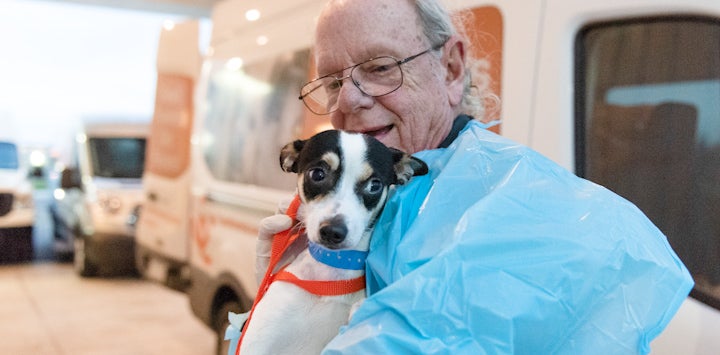
Transports Drive Lifesaving for Rural Shelters
We’ve all heard about shelters experiencing a surge in the number of foster homes and adoptions over the past few months, but the story is a little different for Albany Humane Society (AHS) in Georgia. AHS is in a city with the fourth-highest outbreak of coronavirus per capita in the country and has struggled to move any of its pets. That is, until its plea for help was met with an enthusiastic show of support from peers ready to transport AHS’s cats and dogs out of the area.
Local support lacking in areas hit hard by COVID
Almost from the first days of the outbreak, AHS experienced a devastating impact on its operations when two employees tested positive. Both staff—and an additional 10 employees who were exposed to them—were sent into quarantine.
“We were fearful that more employees would come down with the virus and we wouldn't have anyone left to take care of the animals,” AHS co-director and board member Lulu Kaufman told me. “At that point we had six staff and approximately 130 animals left at the shelter and we had no adoptions or fosters.”
Lulu reached out to the team at Best Friends Atlanta and we shared the message with members of the Georgia Animal Shelter Alliance. Meanwhile, she reached out to Dougherty County Emergency Management, who asked the Georgia Department of Agriculture to send an email to all the rescues and shelters in the state asking them for help.
Within a week, Best Friends pulled ten dogs from them and Atlanta-based groups Lifeline Animal Project, PAWS Atlanta, Atlanta Humane Society and Furkids, as well as Cross Critters Rescue Inc. in Nashville, GA, had cleared the shelter of all but 15 dogs and nine cats. By working together, we were able to get all available animals out of the shelter and remove some of the pressure from the staff.
Already thrilled to have its kennels cleared out, the staff at AHS experienced another gift thanks to other groups stepping in to assist them. Now that they finally had time to work with the behaviorally challenged dogs in their care, they were shocked to find out that they were anything but.
Dogs may have been labeled as aggressive due to behavior they displayed within the kennel or based on notes from the owners upon relinquishment. Now that staff had more time to evaluate dogs outside of their kennels, and even within play groups, they were pleasantly surprised.
“These are dogs that would have been euthanized for space. We found that they are great dogs, some of whom have behavior issues that just need a little work. And now many have gone to rescues or been adopted into new homes,” Lulu says.
Other shelters share the wealth
While shelters like AHS that were slammed by the viral outbreak struggled to find resources, others experienced more offers of public support than animals in need of assistance. Wright-Way Rescue (WWR), which has locations in Murphysboro and Morton Grove, Illinois, normally transports 5,000 animals annually out of rural shelters throughout Kentucky, Arkansas, Missouri, Tennessee, Texas and Georgia.
This year, though, they are on track to do about 7,500—thanks in large part to 6,500 foster and adoption applications that flooded in once the shutdown occurred.
“The first week this all started, we intentionally slowed things down because we didn’t know if we would have sick employees or if we would be considered an essential business,” Christy Anderson, executive director and founder, told me. “But we could not believe the public response, which let us double our foster capacity. Once we got the green light from the governor, we hit the ground running on transporting animals in from areas that truly needed the help.”
WWR doesn’t let any grass grow under its feet, either. As soon as the animals arrive, they are processed and placed into foster homes within the same day and about 20 percent of them are adopted by those families. Though the group usually encourages foster homes to find new adoptive homes for the pets they are caring for, right now WWR has so many applications it literally cannot keep up with demand.
“It’s a great place to be when you don’t have enough dogs for your foster requests,” Christy told me. “This experience has helped us establish more partnerships and identify the groups in greatest need. If we can get a lot of these new fosters to stay with us it means we can double our efforts next year, too. COVID-19 fears aside, this has been amazing.”
Considering what the future holds
The experience has Lulu thinking about what the future might hold for AHS, too.
Even before COVID-19, transports were a game-changer for the shelter, reducing the number of pets dying at their facility from 3,000 in years past to only 43 cats and dogs so far in 2020. There is no plan to stop relying on transports for most of the lifesaving work anytime soon, plus a few local adoptions happening using virtual applications and curbside pick-ups. Beyond that, Lulu says she is trying to make the best decisions for AHS based on what she hears from other shelters.
“I’m listening to what everyone else in the region is doing and seeing how it fits for us,” she says. “Having Albany as such a hot spot, it’s scary to think about opening to the public and having ACOs coming in every day again. I want to protect our employees and take care of the animals.”
We could not agree more. While we all do what we do to help animals, at the end of the day it is about supporting each other. After all, humans make saving animals possible. And when organizations help and support each other, it increases our collective capacity to save lives.
Carrie Ducote
Senior Manager, Southeast Region
Best Friends Animal Society
If you enjoyed this program spotlight, you can find our complete catalog of spotlights here.